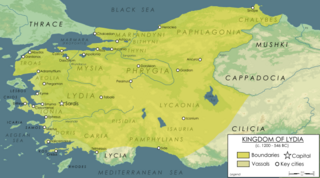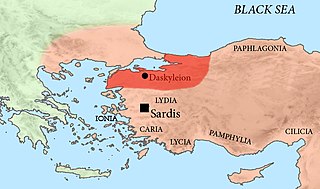Notes
- ↑ 768 BC if based on Eusebius of Caesarea
- ↑ Maximilian Wolfgang Duncker (1852–2008). The History of Antiquity, Vol. 3. Bibliolife. p. 417. ISBN 978-0-559-31747-7.
Cadys (Kadys) was a possibly legendary prince of ancient Lydia.
According to the fragments of Nicolaus of Damascus, possibly based on the lost history of Xanthus of Lydia, the Lydian king Alyattes, of the Mermnadae dynasty, had left his kingdom jointly to his twin sons, Cadys and Ardys. Cadys soon died and his brother ascended the throne as Ardys in 795 BC [1] after an interregnum of civil conflict. [2]

Alyattes, sometimes described as Alyattes I, was the fourth king of the Mermnad dynasty in Lydia, the son of Sadyattes, grandson of Ardys, and great-grandson of Gyges. He died after a reign of 57 years and was succeeded by his son Croesus.

Lydia was an Iron Age kingdom situated in the west of Asia Minor, in modern-day Turkey. Later, it became an important province of the Achaemenid Empire and then the Roman Empire. Its capital was Sardis.

Ionia was an ancient region encompassing the central part of the western coast of Anatolia. It consisted of the northernmost territories of the Ionian League of Greek settlements. Never a unified state, it was named after the Ionians who had settled in the region before the archaic period.
This article concerns the period 639 BC – 630 BC.

Croesus was the king of Lydia, who reigned from 585 BC until his defeat by the Persian king Cyrus the Great in 547 or 546 BC. According to Herodotus, he reigned 14 years. Croesus was renowned for his wealth; Herodotus and Pausanias noted that his gifts were preserved at Delphi. The fall of Croesus had a profound effect on the Greeks, providing a fixed point in their calendar. "By the fifth century at least", J. A. S. Evans has remarked, "Croesus had become a figure of myth, who stood outside the conventional restraints of chronology."

Gyges was the founder of the Mermnad dynasty of Lydian kings and the first known king of the Lydian kingdom to have attempted to transform it into a powerful empire. Gyges reigned 38 years according to Herodotus.

The Cimmerians were an ancient Eastern Iranic equestrian nomadic people originating in the Pontic–Caspian steppe, part of whom subsequently migrated into West Asia. Although the Cimmerians were culturally Scythian, they formed an ethnic unit separate from the Scythians proper, to whom the Cimmerians were related and who displaced and replaced the Cimmerians.

Antiochus III the Great was a Greek Hellenistic king and the 6th ruler of the Seleucid Empire, reigning from 223 to 187 BC. He ruled over the region of Syria and large parts of the rest of West Asia towards the end of the 3rd century BC. Rising to the throne at the age of eighteen in April/June 223 BC, his early campaigns against the Ptolemaic Kingdom were unsuccessful, but in the following years Antiochus gained several military victories and substantially expanded the empire's territory. His traditional designation, the Great, reflects an epithet he assumed. He also assumed the title Basileus Megas, the traditional title of the Persian kings. A militarily active ruler, Antiochus restored much of the territory of the Seleucid Empire, before suffering a serious setback, towards the end of his reign, in his war against Rome.
Sadyattes was the third king of the Mermnad dynasty in Lydia, the son of Ardys and the grandson of Gyges of Lydia. Sadyattes reigned 12 years according to Herodotus.
The year 644 BC was a year of the pre-Julian Roman calendar. In the Roman Empire, it was known as year 110 Ab urbe condita. The denomination 644 BC for this year has been used since the early medieval period, when the Anno Domini calendar era became the prevalent method in Europe for naming years.

Ariobarzanes, sometimes known as Ariobarzanes I of Cius, was a Persian Satrap of Phrygia and military commander, leader of an independence revolt, and the first known of the line of rulers of the Greek town of Cius who eventually were to stem the kings of Pontus in the 3rd century BCE. Ariobarzanes was apparently a cadet member of the Achaemenid dynasty, possibly son of Pharnabazus II, and part of the Pharnacid dynasty which had settled to hold Dascylium of Hellespont in the 470s BCE. Cius is located near Dascylium, and Cius seemingly was a share of family holdings for the branch of Ariobarzanes.

Molon or Molo was a general and satrap of the Seleucid king Antiochus the Great. He held the satrapy of Media at the accession of that monarch ; in addition to which, Antiochus conferred upon him and his brother Alexander the government of all the upper provinces of his empire. But their hatred of Hermeias, the chief minister of Antiochus, soon led them both to revolt in 222 BC. The two generals at first sent against them by the king were unable to oppose their progress, and Molon found himself at the head of a large army, and master of the whole country to the east of the Tigris.
Madyes was a Scythian king who ruled during the period of the Scythian presence in West Asia in the 7th century BCE.
Ardys was the son of Gyges of Lydia, whom he succeeded as the second king of the Mermnad dynasty.
Ardys or Ardysus may refer to:
Sandakshatru or Sandakuru was the last known Cimmerian king.

The prehistory of Anatolia stretches from the Paleolithic era through to the appearance of classical civilization in the middle of the 1st millennium BC. It is generally regarded as being divided into three ages reflecting the dominant materials used for the making of domestic implements and weapons: Stone Age, Bronze Age and Iron Age. The term Copper Age (Chalcolithic) is used to denote the period straddling the stone and Bronze Ages.
Cady is a typically feminine given name and nickname.

The Lydian–Milesian War was a military conflict between the Kingdom of Lydia and the ancient Greek city state of Miletus. It took place during the 7th century BC in the Archaic period, traditionally set between 612 and 600 BC. The main source of the war is Herodotus, who wrote about it in the opening chapters of his Histories. The war ended after 12 years when the tyrant of Miletus, Thrasybulus of Miletus, convinced the Lydian king Alyattes to sue for peace with a ruse, after which an alliance between the two states was forged. Amongst other things, the length of the war has caused debate among modern historians.